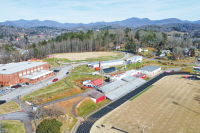Stronger language on the way for Jackson’s steep slope rules

Approval of a 38-home subdivision in Cullowhee has served as a catalyst for the Jackson County Planning Board to revisit the county’s steep slope ordinance, a controversial piece of legislation that passed in 2015 after nearly three years of heartfelt debate. If the last few planning board meetings are any indication, the next round of steep slope discussions will also be a lengthy and complex conversation.
The ordinance aims to regulate development on sensitive mountain slopes and to restrict new construction on ridgetops, where buildings are visible from miles around. Specifically, the ordinance restricts development on protected mountain ridges, which are defined as ridges of at least 2,500 feet in elevation with a minimum drop of 400 feet to the adjacent valley floor
The 21.5-acre Solitude property contained a ridge higher than 2,500 feet with a valley sitting more than 400 feet below it. Nevertheless, ambiguity in the rules allowed the development to get approved, leading the planning board to look at how the rules could be better written to accomplish their intended purpose.
“I think that was exactly the kind of thing it (the ordinance) was written to prevent, but I didn’t think we had strong enough language to be able to do it,” said board member Bonnie Claxton of the Solitude decision. “That’s why I want to strengthen that language, no matter how we do it.”
A question of definition
The issue is that the ordinance contains no definition for “adjacent valley floor.” The ridge in question on the Solitude property had three nearby valleys that could be considered adjacent. Two of them met the 400-foot threshold, and one did not.
Related Items
“We can go with the worst-case scenario there, the most restrictive, but they (the developers) will go back to why did you pick that valley and not that valley over here?” said John Jeleniewski, senior planner for the county. Thus, the planning office had to go with the least restrictive interpretation of the ordinance.
At first, the planning board considered getting rid of the adjacent valley floor provision altogether. Simple elevation is easy to define, easy to map, easy to enforce. Including the adjacent valley floor stipulation makes it harder for the public to understand the ordinance and harder for the county to enforce it. Mapping a protected ridge definition that includes the adjacent valley floor will entail a massive undertaking on the part of Jackson County GIS employees.
However, after an hour-long discussion Dec. 8, planning board members opted to keep the adjacent valley floor provision in the definition. That stipulation is needed, they said, to allow the ordinance to focus its protections on the most prominent ridges in the landscape. Going by elevation alone would restrict development on ridges that feature higher elevations but don’t sit that far above the surrounding landscape.
“The southern end of the county is going to sit higher, so every ridge — just in elevation, whether it’s prominent or not — will be captured, whereas that doesn’t necessarily happen in the central and northern parts of the county,” Michael Poston, the county’s planning director, told the planning board when describing the impact of an ordinance without the adjacent valley floor definition.
Defining adjacent valley floor will only be the beginning of the planning board’s work regarding the steep slope ordinance. Other definitions are needed as well, such as a definition for ridgeline — should the highest point of a ridgeline be the highest point within the boundaries of the property in question, or should county staff trace the path of the ridgeline across multiple parcels to determine the highest elevation?
“It’s almost like trying to describe how to tie your shoe in writing,” said Board Chairman Scott Baker — get one word wrong or omit one minor step, and the whole operation is thrown off.
Then there’s the question of whether rules regarding ridges should even be captured in the steep slope ordinance, which is listed in the county code of ordinances as the mountain hillside development ordinance. The county also has an ordinance called the mountain ridge protection ordinance, which dates back to the 1980s and was adopted to mirror state ridge protection standards.
“As far as our staff is concerned, in enforcement it makes sense for the protected ridge language to be in the protected ridge ordinance instead of splintered off in another ordinance,” Jeleniewski said.
But before the two ordinances can be sorted out, some key differences will have to be resolved. The ridge protection ordinance defines a protected ridge as one that’s 3,000 feet in elevation with a 500-foot drop to the adjacent valley floor — again with no definition for adjacent valley floor. The steep slope ordinance is more restrictive, putting a protected ridge at 2,500 feet or greater with a 400-foot drop to the adjacent valley floor.
“We need to have that standard the same across both of them,” Baker said.
Board make-ups set to change
Ultimately, the planning board will be working to pull all the county’s disparate zoning ordinances into a single, comprehensive ordinance. That will be a gargantuan task requiring a significant investment of time. But merging the steep slope and protected ridge ordinances now won’t create extra work, Poston said. Any work done to merge the two ordinances can simply be rolled into the larger task of creating a unified land development ordinance.
However, merging the ordinances could cause the knotty issues that made the last steep slope revision process so divisive to resurface.
“I don’t believe that any of these problems that we’re talking about here are insurmountable that we can’t come to some equitable definition of an adjacent valley floor or a ridgetop or a lemonade stand,” said board member Ken Brown. “What I think it boils down to is a philosophical question of whether you want to give more protection to what’s left of the county that we can protect.”
The consensus on the philosophical side of the revision could be influenced by the results of the 2016 election. When the steep slope revision process began in 2013, it was under the supervision of a board of commissioners composed of two Democrats, two Republicans and one Independent. When Democrats took control in the 2014 elections, the revision process — guided by board members who had been appointed by the newly Democratic board — favored a more restrictive approach to steep slope development.
In November, Republicans Ron Mau and Mickey Luker unseated Democratic incumbents Vicki Greene and Mark Jones, and it remains to be seen what — if any — impact the new membership will have on the direction of steep slope revisions. At the end of December, five terms on the 11-member planning board will expire, and it will be up to the new board of commissioners to fill those seats.
The revision process will be a lengthy one likely to require several more months to complete, so the new planning board members will have an impact on the final result. And, because commissioners are the ones who have ultimate say as to whether a planning board draft becomes an ordinance, so will the opinions of the new commissioners.
“For us to be able to go and take something to the commissioners, we’re going to need to have buy-in from the existing board at that time,” Baker said.









